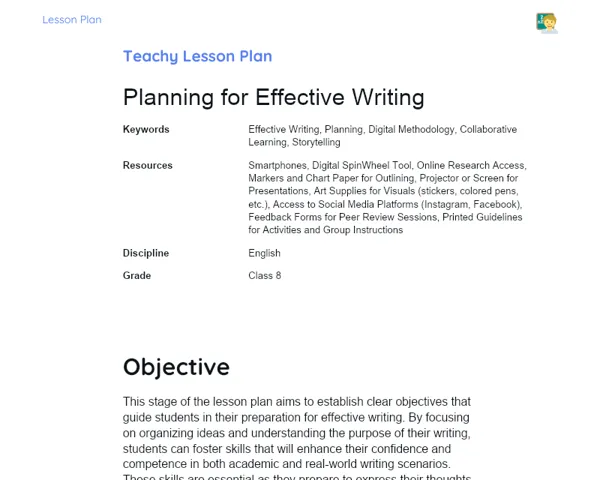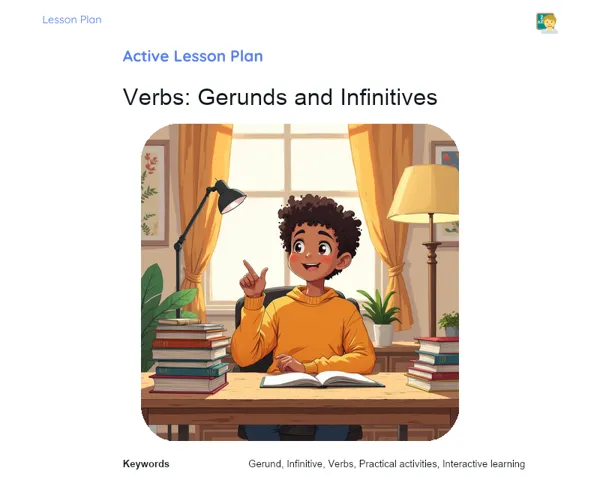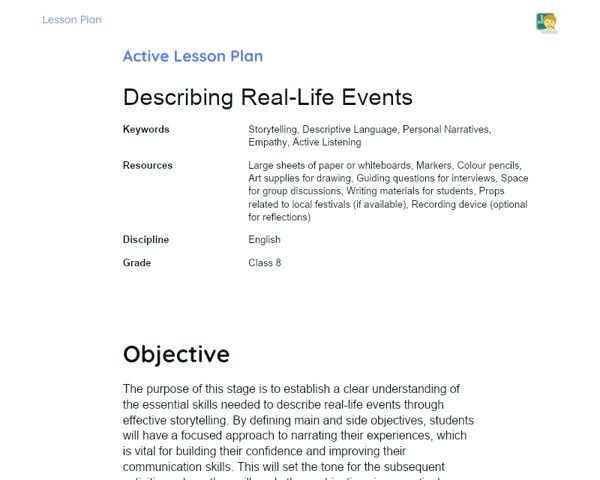Lesson Plan | Active Methodology | Antonyms and Synonyms
| Keywords | Antonyms, Synonyms, English, Communication, Hands-on activities, Collaboration, Critical thinking, Engagement, Group discussion, Reflection, Learning consolidation |
| Necessary Materials | Cards with English words and spaces for emojis, Electronic devices with internet access, Word lists in English, Materials for group performances (if required) |
Premises: This Active Lesson Plan assumes: a 100-minute class duration, prior student study both with the Book and the beginning of Project development, and that only one activity (among the three suggested) will be chosen to be carried out during the class, as each activity is designed to take up a large part of the available time.
Objective
Duration: (5 - 10 minutes)
This Objectives stage is vital for clearly outlining expectations for student learning and application during the lesson. The emphasis is on enabling students to not just identify antonyms and synonyms but also utilize this knowledge in practical and varied situations. This clarity sets the tone for subsequent activities, keeping students engaged and focused on the learning goals.
Objective Utama:
1. Help students identify and differentiate between antonyms and synonyms in English, using the example of 'short' and 'tall'.
2. Encourage students to apply their understanding of antonyms and synonyms in different scenarios, enhancing their English communication skills.
Objective Tambahan:
Introduction
Duration: (15 - 20 minutes)
The introduction stage aims to engage students and link their prior knowledge to the lesson’s topic. The proposed situations encourage critical thinking on the practical use of antonyms and synonyms, while the contextualization underscores their importance in effective communication. This creates a foundation for deeper understanding during class activities.
Problem-Based Situation
1. Imagine you're reading an article in English and you come across the word 'tall'. How might you determine its opposite without looking it up?
2. Think of a time you needed to describe something as 'short', but your friend didn’t quite get it. How can knowing antonyms assist in making your point clearer?
Contextualization
Antonyms and synonyms play a crucial role in mastering the English language, helping us express thoughts with accuracy and clarity. For instance, knowing that 'short' is the opposite of 'tall' can avert misunderstandings in day-to-day interactions or academic discussions. It's also fascinating to note that 'cleave' can mean both 'to unite' and 'to separate' in English, showcasing the complexity and richness of language.
Development
Duration: (65 - 75 minutes)
The Development stage is crafted to enable students to apply and bolster their prior knowledge of antonyms and synonyms in an engaging and practical manner. The activities promote teamwork, fostering collaboration and discussion, thereby enhancing understanding of language concepts while boosting communication and critical thinking skills. Each activity is thoughtfully designed to be interactive and enjoyable, ensuring students stay actively involved in the learning journey.
Activity Suggestions
It is recommended that only one of the suggested activities be carried out
Activity 1 - Emoji Pairs
> Duration: (60 - 70 minutes)
- Objective: Reinforce the understanding and application of antonyms and synonyms in a playful and collaborative setting.
- Description: In this fun activity, students will be divided into groups of up to 5. Each group receives cards, each bearing an English word with a blank space alongside. The task is to find the corresponding antonym or synonym for each word and denote it with emojis.
- Instructions:
-
Form groups of up to 5 students.
-
Distribute the cards, ensuring each has a word and an emoji space.
-
Students discuss and decide which emoji best represents the antonym or synonym of the word.
-
Each group presents their choices and explains the reasoning for their emoji selections.
-
Review the answers as a class, discussing the different meanings and applications of antonyms and synonyms.
Activity 2 - The Synonym Challenge
> Duration: (60 - 70 minutes)
- Objective: Enhance research skills and apply synonyms in real communication situations.
- Description: In this group activity, students are given a list of English words. They need to find synonyms for these words using online tools like dictionaries and translators. After gathering information, each group crafts a short dialogue utilizing the words and their synonyms and presents it to the class.
- Instructions:
-
Form groups of up to 5 students.
-
Distribute the word lists to each group.
-
Allow students to use devices to find synonyms for their words.
-
Each group creates a short dialogue including the original words and their synonyms.
-
Present the dialogues to the class, discussing the synonym choices and their communication effects.
Activity 3 - Antonym Theater
> Duration: (60 - 70 minutes)
- Objective: Deepen understanding of antonyms and their use in diverse communication contexts.
- Description: In this engaging activity, each group selects a pair of antonyms and creates a short skit that showcases the proper usage of these terms in various contexts. Each group subsequently performs their skit for the class.
- Instructions:
-
Divide students into groups of up to 5.
-
Each group selects a pair of antonyms.
-
Prepare a short skit that creatively integrates the chosen antonyms.
-
Perform the skits for the class, allowing each group to explain the context of their antonyms after their performance.
-
Discuss the presentations, emphasizing the application of antonyms in different scenarios.
Feedback
Duration: (15 - 20 minutes)
The aim of this feedback stage is to consolidate learning, allowing students to reflect on their experiences and share perspectives with classmates. The group discussion reinforces their grasp of antonyms and synonyms, fostering communication and argumentation skills. This also provides an opportunity for the teacher to assess comprehension levels and identify areas needing further attention.
Group Discussion
Once the activities are complete, gather all students for a roundtable discussion. Invite each group to share their most interesting findings about antonyms and synonyms. Encourage an open dialogue on how they plan to use this knowledge in real English communication settings. This stage is essential for students to articulate and reflect on their learnings, while also benefiting from each other's insights.
Key Questions
1. What challenges did you encounter while identifying antonyms and synonyms, and how did you tackle them?
2. In what ways can understanding antonyms and synonyms enhance comprehension during conversations or in reading English texts?
3. Was there a particular synonym or antonym that took you by surprise? If so, why?
Conclusion
Duration: (10 - 15 minutes)
The conclusion stage is critical for ensuring that students have a solid understanding of the topics discussed throughout the lesson. Summarizing concepts, linking theory with practical application, and highlighting the significance of what they've learned equips students to use their knowledge in real-world scenarios. This moment also enables the teacher to gauge overall comprehension and address any lingering questions.
Summary
In this final stage, the teacher should recap the main points discussed regarding antonyms and synonyms, revisiting their definitions and examples covered. It's important to highlight the activities conducted and the discoveries made by students, demonstrating how these concepts apply in a variety of contexts.
Theory Connection
The teacher should explain the connection between the theory of antonyms and synonyms and their practical applications, using real-life examples and interactive activities to cement learning. Emphasizing the significance of recognizing and utilizing antonyms and synonyms for effective communication in English, both spoken and written, is crucial.
Closing
Lastly, the teacher should underline the importance of antonyms and synonyms in everyday communication, illustrating how proper use can mitigate misunderstandings and enrich exchanges. This final moment solidifies the relevance of what has been learned and encourages students to continue exploring and employing these concepts in their language practices.



